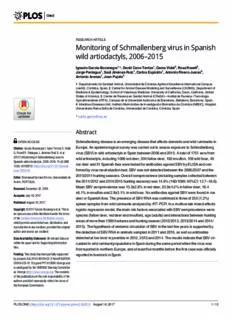
Monitoring of Schmallenberg virus in Spanish wild artiodactyls, 2006–2015 PDF
Preview Monitoring of Schmallenberg virus in Spanish wild artiodactyls, 2006–2015
RESEARCHARTICLE Monitoring of Schmallenberg virus in Spanish wild artiodactyls, 2006–2015 IgnacioGarc´ıa-Bocanegra1*,DavidCano-Terriza1,GemaVidal2,RosaRosell3, JorgePaniagua1,Sau´lJime´nez-Ruiz1,CarlosExpo´sito1,AntonioRivero-Juarez4, AntonioArenas1,JoanPujols3 1 DepartamentodeSanidadAnimal,UniversidaddeCo´rdoba-AgrifoodExcellenceInternationalCampus (ceiA3),Co´rdoba,Spain,2 CenterforAnimalDiseaseModelingandSurveillance(CADMS),Departmentof Medicine&Epidemiology,SchoolofVeterinaryMedicine,UniversityofCalifornia,Davis,California,United StatesofAmerica,3 CentredeRecercaenSanitatAnimal(CReSA)—InstitutdeRecercaiTecnologia a1111111111 Agroalimentàries(IRTA),CampusdelaUniversitatAutònomadeBarcelona,Bellaterra,Barcelona,Spain, a1111111111 4 InfectiousDiseasesUnit.InstitutoMaimo´nidesdeInvestigacio´nBiome´dicadeCo´rdoba(IMIBIC),Hospital a1111111111 UniversitarioReinaSof´ıadeCo´rdoba,UniversidaddeCo´rdoba,Co´rdoba,Spain a1111111111 a1111111111 *[email protected] Abstract OPENACCESS Schmallenbergdiseaseisanemergingdiseasethataffectsdomesticandwildruminantsin Europe.AnepidemiologicalsurveywascarriedouttoassessexposuretoSchmallenberg Citation:Garc´ıa-BocanegraI,Cano-TerrizaD,Vidal G,RosellR,PaniaguaJ,Jime´nez-RuizS,etal. virus(SBV)inwildartiodactylsinSpainbetween2006and2015.Atotalof1751serafrom (2017)MonitoringofSchmallenbergvirusin wildartiodactyls,including1066reddeer,304fallowdeer,192mouflon,109wildboar,49 Spanishwildartiodactyls,2006–2015.PLoSONE roedeerand31SpanishibexweretestedforantibodiesagainstSBVbyELISAandcon- 12(8):e0182212.https://doi.org/10.1371/journal. pone.0182212 firmedbyvirusneutralizationtest.SBVwasnotdetectedbetweenthe2006/2007andthe 2010/2011huntingseasons.Overallseroprevalence(includingsamplescollectedbetween Editor:EmmanuelSerranoFerron,Universidadede Aveiro,PORTUGAL the2011/2012and2014/2015huntingseasons)was14.6%(160/1099;95%CI:12.7–16.6). MeanSBVseroprevalencewas13.3±2.6%inreddeer,23.9±4.2%infallowdeer,16.4 Received:December22,2016 ±6.1%inmouflonand2.8±3.1%inwildboar.NoantibodiesagainstSBVwerefoundinroe Accepted:July16,2017 deerorSpanishibex.ThepresenceofSBVRNAwasconfirmedinthreeof255(1.2%) Published:August16,2017 spleensamplesfromwildruminantsanalysedbyrRT-PCR.Inamultivariatemixed-effects Copyright:©2017Garc´ıa-Bocanegraetal.Thisis logisticregressionmodel,themainriskfactorsassociatedwithSBVseroprevalencewere: anopenaccessarticledistributedundertheterms species(fallowdeer,reddeerandmouflon),age(adults)andinteractionsbetweenhunting oftheCreativeCommonsAttributionLicense, areasofmorethan1000hectaresandhuntingseason(2012/2013,2013/2014and2014/ whichpermitsunrestricteduse,distribution,and reproductioninanymedium,providedtheoriginal 2015).ThehypothesisofendemiccirculationofSBVinthelastfewyearsissupportedby authorandsourcearecredited. thedetectionofSBVRNAinanimalssampledin2011and2015,aswellasantibodies DataAvailabilityStatement:Allrelevantdataare detectedatlowlevelinjuvenilesin2012,2013and2014.TheresultsindicatethatSBVcir- withinthepaperanditsSupportingInformation culatedinwildruminantpopulationsinSpainduringthesameperiodwhentheviruswas files. firstreportedinnorthernEurope,andatleastfivemonthsbeforethefirstcasewasofficially Funding:Thisstudyhasbeenpartiallysupported reportedinlivestockinSpain. byprojectsAGL2013-49159-C2-2-RandFAU2008- 00019-C03-01.EUgrantFP7-613996Vmergeand iscataloguedbytheVMERGESteeringCommittee asVmerge(http://www.vmerge.eu).Thecontents ofthispublicationarethesoleresponsibilityofthe authorsanddon’tnecessarilyreflecttheviewsof theEuropeanCommission. PLOSONE|https://doi.org/10.1371/journal.pone.0182212 August16,2017 1/12 SchmallenbergvirusinwildartiodactylsinSpain Competinginterests:Theauthorshavedeclared Introduction thatnocompetinginterestsexist. Schmallenbergvirus(SBV)isanarthropod-borneOrthobunyavirusoftheSimbuserogroup (familyBunyaviridae),whichaffectsdomesticandwildruminantspecies.Thevirusismainly transmittedbybitingmidgesofthegenusCulicoides.Inadultanimals,thesyndromeisacute andnon-specific.Inpregnantruminants,however,infectioncanleadtoabortions,stillbirths andcongenitalmalformationsinnewbornanimals[1].Schmallenbergviruswasfirstreported inNorthRhine-Westphalia(Germany)insummer2011.Sincethen,thevirushasemerged andre-emergedinlivestockinvariousEuropeancountries.Spainreportedthefirstoutbreak ofSchmallenbergdiseaseinMarch2012,inaflockofsheepintheprovinceofCordoba(south- ernSpain)[2].Fetalmalformationsobservedinthisflockincludedarthrogryposis,lordosis andcerebellarhypoplasia[3]. Inthelastfewyears,serosurveyshaverevealedwidespreadexposuretoSBVamongwild artiodactylspeciesindifferentEuropeancountries.SBVseropositivityhasbeendetectedin reddeer(Cervuselaphus)(range6.0%–71.4%),fallowdeer(Damadama)(rangingfrom0.0% to56.3%),roedeer(Capreoluscapreolus)(rangingfrom27.3%to80.0%),Pyreneanchamois (Rupicaprapyrenaica)(7.6%),Europeanbison(Bisonbonasus)(range76.1%–81.8%),Alpine chamois(R.rupicapra)(4.5%),elk(Alcesalces)(22%),Europeanmouflon(Ovisariesmusimon) (range0.0%–75.0%),Alpineibex(Capraibex)(33.3%)andwildboar(Susscrofa)(range 15.3%–23.4%)[2–12].Theseroprevalencelevelsdetectedinwildartiodactylsraisestheques- tionofwhetherthesespeciesplayaroleintheepidemiologyofSBV,ashaspreviouslybeen indicatedinrelationtobluetonguevirus[13]. Thegeographicaldistributionofdifferentwildartiodactylspeciesandpopulationdensities, particularlyofreddeer(Cervuselaphus)andwildboar(Susscrofa),haveincreasedsubstan- tiallyinSpaininrecentdecades[14,15],whichhasledtothefrequentsharingofhabitatswith domesticlivestockandthesubsequentincreaseintheriskofdiseasetransmission[16].Even thoughwildartiodactylshavebeensuggestedasapotentialreservoirofSBV,information abouttheroleofwildlifeinthetransmissionandmaintenanceofSBVinMediterraneaneco- systemsisstillverylimited.Inthecontextofgrowingandexpandingwildungulatepopula- tions,wehypothesizedthatthesespeciesmaybeimplicatedintheepidemiologyofSBVin Mediterraneanecosystems.Threehypothesesweretested:a)SBVwascirculatingamongSpan- ishwildartiodactylsbeforethefirstoutbreakwasreportedinlivestock;b)wildartiodactyls mayactasanaturalreservoirofSBVinSpain;c)SBVisendemicinthiscountry,eventhough nooutbreakshavebeenreportedinlivestockinthelastfewyears. Materialandmethods Ethicsstatement Thisstudydidnotinvolvepurposefulkillingofanimals.Noanimalswerespecificallyhunted forthisstudyandethicalapprovalbyanInstitutionalAnimalCareandUseCommitteewas notdeemednecessary.Allsampleswerecollectedfromlegallyhuntedindividuals,byautho- rizedhunterswiththecorrectpermitsandlicensesandwiththepermissionoflandowners. AnimalsweresampledduringthehuntingseasonunderSpanishandEUlegislation.Allcollec- tionofsampleswasperformedfollowingroutineproceduresbeforethedesignofthisstudy,in compliancewiththeEthicalPrinciplesinAnimalResearch.Protocols,amendmentsandother resourceswerecompletedaccordingtoguidelinesapprovedbyeachregionalautonomous governmentfollowingtheR.D.1337/2013oftheMinistryofPresidencyofSpain(1stFebruary 2013,BOE8thFebruary2013)(https://www.boe.es/diario_boe/txt.php?id=BOE-A-2013- 1337)). PLOSONE|https://doi.org/10.1371/journal.pone.0182212 August16,2017 2/12 SchmallenbergvirusinwildartiodactylsinSpain Sampling Atotalof1751wildartiodactylsweresampledin75huntingareasinnineprovinceslocatedin south-centralSpain(36˚N—38˚60´N,1˚75´W—7˚25´W)betweenthehuntingseasons 2006/2007and2014/2015(Fig1).ThestudyareaischaracterisedbyacontinentalandMedi- terraneanclimate,withmildwinters,hotdrysummers,andrainyseasonsintheautumnand spring.ThisareapresentsoneofthehighestdensitiesofwildartiodactylsinSpaindueto intensivebiggamemanagement[14,15],withfrequentsharingofhabitatswithlivestock[17]. Bloodwascollectedfromreddeer(n=1066),fallowdeer(n=304),Europeanmouflon (n=192),wildboar(n=109),roedeer(n=49)andSpanishibex(Caprapyrenaicahispanica) (n=31).Seropositivityaccordingtohuntingseason,speciesandprovinceisshowninS1 Table.Theanimalswereclassifiedintothreeagegroupsbasedontoothreplacement:yearlings (<1yearold),sub-adults(between1and3yearsold)andadults(>3yearsold)[18].Allsam- pleswereclassifiedaccordingtosex.Bloodsamplesweretakenfromthethoraciccavityorby punctureoftheduralvenoussinuses,aspreviouslydescribed[19,20].Sampleswereplaced intosteriletubesandcentrifugedat400gfor15minutes.Serawerestoredat-20˚Cuntil tested.Inaddition,spleensampleswerecollectedatnecropsyforSBVRNAdetectionand storedat-80˚Cuntilrequiredforanalysis. Anepidemiologicalquestionnaire,includingdataontheanimalssampledandhunting areas,wasalsocompletedbydirectinterviewwithgamekeepersateachhuntingground.The questionnaireswerespecificallydesignedwithclosed-endedquestionstoavoidambiguousor lengthyanswersindatacollection.Epidemiologicalinformationrelatedtothesampled Fig1.SpatialdistributionofSBVinwildartiodactylsinsouthernSpain.Blackandwhitedotsindicatepositiveandnegativehuntingareas,respectively. WhitetrianglesindicateSBVRNA-positiveanimalsdetected.BlacksquareindicatesthegeographicallocationofthefirstSBVoutbreakinlivestockreported inSpain. https://doi.org/10.1371/journal.pone.0182212.g001 PLOSONE|https://doi.org/10.1371/journal.pone.0182212 August16,2017 3/12 SchmallenbergvirusinwildartiodactylsinSpain animals,sampling-sitefeaturesandenvironmentalfeatureswereincludedinthequestionnaire toobtaininformationaboutlevelsofexposuretopotentialriskfactors. Laboratoryanalyses ThepresenceofantibodiesagainsttheSBVNproteinwasdeterminedusingthecommercial blockingenzyme-linkedimmunosorbentassay(bELISAR.13.SBV.K3INgezimSchmallenberg Compac1,Ingenasa,Madrid,Spain)(sensitivity98%,specificity99%),accordingtothemanu- facturer’srecommendations.bELISAwasusedforserologicalscreening,andpositiveand doubtfulserabybELISAweretestedbyvirusneutralisationtest(VNT)aspreviouslydescribed, withminormodifications[21].Briefly,serawereheat-inactivatedand2-folddilutedfrom1:5to 1:640.FiftymicrolitersofeachdilutionweremixedwithanequalvolumeofEMEMcontaining 10050%tissuecultureinfectivedoses(100TCID50)ofSBV(BH80/11-4,kindlyprovidedby theFriedrich-LoefflerInstitute,Germany),thenincubatedforonehourat37˚C.Approximately 15,000Verocellsin100μlofEMEMsupplementedwith10%fetalcalfserumwerethenadded toeachwell.Theplateswereincubatedfor3–5daysat37˚Cunder5%CO atmosphere.The 2 cellswereexaminedbylightmicroscopyat3and6daysforthepresenceofSBV-specificcyto- pathogeniceffects.Toexcludeindividualserumtoxicity,onecontrolwellwithouttheviruswas included.Positivecontrols(FLI-SBV0112positivesera)wereincludedineachanalysis.Titres wereexpressedasthereciprocalofthehighestdilutionthatneutralised100tissuecultureinfec- tivedoses(100TCID )inVerocells.Onlysamplesthatshowedneutralisation(absenceofcyto- 50 pathiceffect(CPE))atdilutions(cid:21)1:5wereconsideredpositive.Thecellswereexamineddaily bylightmicroscopyforthepresenceofSBV-specificcytopathogeniceffects.Seropositivitywas determinedfromsamplespositivebybELISAandVNT. TestingforthepresenceofviralSBVRNAwasperformedon255spleensamplestaken fromwildartiodactylssampledinhuntingareaswhereatleastoneseropositiveanimalwas detected.ThespleenisconsideredatargettissueforSBVRNAdetectioninruminantsbecause viralRNAcanbedetectedinitupto5weeksafterinfection[22].ViralRNAwasextracted directlyfromthespleenusingacommercialkit(MagAttract196cador1PathogenKitQIA- GEN).Sampleswereanalysedusingreal-timereversetranscriptase-PCR(rRT-PCR)detecting aconservedregioninthesmall(S)segmentoftheSBVgenome[23].Negativeandpositive (BH80/11-4)controlswereincludedineachanalysis. Statisticalanalysis TheestimatedprevalenceofantibodiesagainstSBVwascalculatedfromtheratioofpositives tothetotalnumberofsamplesexamined,usingexactbinomialconfidenceintervals(95%CI) [24].Samplescollectedbeforethe2011/2012huntingseason,whenthefirstseropositiveani- malwasdetected,wereexcludedtodetermineoverallseroprevalence.Inordertodetectnon- linearrelationshipsandtostandardisethescalesofexplanatoryvariables,continuousvariables werecategorizedaccordingtohuntingmanagementcriteriaforthevariable“surfacehunting area”(<1000hectaresand>1000hectares),andusingthe33and66percentilesascut-off pointsforthevariable“distancetothenearesttown”(<5km,5–10kmand>10km).Fre- quencieswerecomputedandvariablesre-categorizedonthebasisofbiologicalrelevance whennecessary.Inordertopreventcollinearity,Cramer’sVcoefficientbetweenpairsofvari- ableswascomputedandthosewithacoefficientgreaterthan0.60wereconsideredtobecorre- latedandwerenotincludedtogetherinthesamemodel.Whencollinearvariableswere detected,onlythevariablewiththeaprioristrongerbiologicalassociationwithSBVseroposi- tivitywasretained.Pearson’schi-squaretestorFisher’sexact,whentherewerefewerthansix PLOSONE|https://doi.org/10.1371/journal.pone.0182212 August16,2017 4/12 SchmallenbergvirusinwildartiodactylsinSpain observationspercategory,wasalsoappliedforindependenceofexplanatoryvariablesaccord- ingtooutcome. AssociationsbetweenexplanatoryvariablesandSBVseropositivityweretestedbyfittinga mixed-effectslogisticregressionmodeltoeachofthestudyvariables,allowingdifferentinter- ceptsfor“huntingarea”.Allstatisticallysignificantvariables(likelihoodratioandWaldtest,P- value<0.10)inthebivariateanalysiswereselectedaspotentialriskfactors.Finally,amixed- effectslogisticregressionmodelwithdifferentinterceptsforeachhuntingareawasfittedin ordertostudytheeffectofthevariablesselectedonthebasisofbivariateanalysis.SBVseropos- itivitywasassumedtofollowabinomialdistribution.Forforwardmodelbuilding,variables wereincludedoneatatime,startingwiththevariablewiththelowestP-valueinbivariateanal- ysis.Iftwovariablescorrelatedwitheachother,onlythevariablewiththestrongeststatistical associationwiththeoutcomewasretained.Ateachstep,theconfoundingeffectoftheincluded variablewasassessedbycomputingthechangeintheoddsratio.Confoundingvariableswere thosethat,whenaddedtothemodel,changedtheORbymorethan30%,andwereforcedinto thefinalmodelregardlessoftheirsignificancelevel.Potentialtwo-wayinteractionsbetweenall thevariablesweretestedforsignificanceinthemodel.Akaike’sInformationCriterion(AIC) wasusedformodelcomparisonandselection,withthelowestAICindicatingthebestfit.Sta- tisticalanalyseswereperformedusingRopen-sourcestatisticalsoftware[25].Thelibraries usedfromRstatisticalsoftwarewerelmer4[26],foreign[25],stats[25],vcd[27],arm[28], andtidyverse[29]aspackagewrapper. Results Atotalof179(10.2%)of1751seracollectedfromwildartiodactylstestedpositiveforSBVby bELISA.SevensamplescouldnotbeanalysedbytheVNTduetoserumcytotoxicity.Twelve serawereconsideredfalsepositivesbecausetheywerepositivebybELISAbutnegativeby VNT,sothattheoverallfrequencyofseropositiveswas9.2%(160/1744).Betweenthe2006/ 2007andthe2010/2011huntingseasons,SBVantibodieswerenotdetectedincirculation.The overallseroprevalenceinwildartiodactyls(includingsamplescollectedbetweenthe2011/2012 andthe2014/2015huntingseasons)was14.6%(160/1099;95%CI:12.7–16.6).MeanSBVsero- prevalencewas13.3±2.6%(87/653)inreddeer,23.9±4.2%(47/197)infallowdeer,16.4±6.1% (23/140)inmouflon,and2.8±3.1%(3/109)inwildboar.Seroprevalencewassignificantly higherinallwildruminantspeciesthaninwildboar(P<0.001). SeropositivitywassignificantlyhigherintheprovinceofCordoba(16.5%;157/952)com- paredtoCadiz(4.2%;2/48;Fisher’sexacttest=5.19,P=0.011)orJaen(2.9%;1/35;Fisher’s exacttest=4.66,P=0.016),theonlyprovinceswhereSBVcirculationwasfound(Fig1). Twentyfouroutof49(48.9%)areassampledduringthe2011/2012huntingseasonpresented atleastoneseropositiveanimal.Seropositivitywasfoundbetween2011/2012and2014/2015. Seropositiveyearlingsweredetectedduringthehuntingseasonsof2012/2013(ninereddeer andonemoufloninCordoba),2013/2014(onefallowdeerinCadiz)and2014/2015(threered deerandonefallowdeerinCordoba)(Fig1). Atotalof17explanatoryvariableswereconsideredforthebivariateanalysisofSBVsero- positivityinwildartiodactylspeciesinCordobaprovince(southernSpain)(Table1).Ninevar- iableswerefinallyselectedfromthebivariatemixed-effectsmodel(P<0.10)(Table1).Sex wasexcludedfromthemultivariateanalysisduetocollinearitywiththevariable“species”, while“presenceoffallowdeer”and“presenceofdomesticruminants”showedcollinearity with“surfaceofhuntingarea”. Themultivariatemixed-effectslogisticregressionmodel(AICof731)showedthatthemain riskfactorspotentiallyassociatedwiththeindividualriskofinfectionbySBVinwild PLOSONE|https://doi.org/10.1371/journal.pone.0182212 August16,2017 5/12 SchmallenbergvirusinwildartiodactylsinSpain Table1. ExplanatoryvariablesincludedinthebivariateanalysisofSchmallenbergvirusseropositivityinwildartiodactylspeciesinCordobaprov- ince,southernSpain. Variable Category Seroprevalence(%) N˚positives/total P-value Wildboar 2.8 3/108 0.003 Species* Reddeer 15.7 86/547 Mouflon 17.2 23/134 Fallowdeer 27.6 45/163 Yearlings 11.4 14/123 0.014 Age* Sub-adults 16.8 52/310 Adults 18.5 89/481 Sex* Male 18.4 114/621 0.006 Female 13.2 43/326 2011/2012 4.4 7/158 <0.001 Huntingseason* 2012/2013 25.5 41/161 2013/2014 18.4 44/239 2014/2015 16.5 65/394 Surfaceareaofthehuntingarea(inhectares)* <1000 7.1 20/283 <0.001 >1000 20.5 137/669 Supplementaryfeeding No 7.0 7/100 0.109 Yes 17.6 150/852 Fenced No 17.8 120/673 0.471 Yes 13.3 37/279 Restocking No 16.4 154/939 0.365 Yes 23.1 3/13 Distancetothenearesttown <5km 21.1 67/317 0.508 5–10km 11.3 35/310 >10km 16.9 55/325 Highdensityofreddeer* No 4.9 5/103 0.022 Yes 17.9 152/849 Presenceoffallowdeer* No 8.2 35/425 <0.001 Yes 23.1 122/527 Presenceofmouflon No 15.6 94/604 0.292 Yes 18.1 63/348 Presenceofdomesticruminants* No 19.1 150/786 0.001 Yes 4.2 7/166 Presenceofrivers* No 8.3 20/241 0.040 Yes 19.3 137/711 PresenceofMediterraneanscrub No 9.9 23/233 0.556 Yes 18.6 134/719 Presenceofdehesa No 9.4 13/138 0.781 Yes 17.7 144/814 Presenceofpineforest No 12.1 28/231 0.914 Yes 17.9 129/721 *Explanatoryvariablesselectedfromthebivariatemixed-effectsmodel(P<0.10). https://doi.org/10.1371/journal.pone.0182212.t001 artiodactylswere:species(fallowdeer,reddeerandmouflon),age(adult)andinteraction betweensurfaceareaofthehuntingground(>1000hectares)andhuntingseason(2012/2013, 2013/2014and2014/2015)(Table2).Significantlyhigherseropositivitywasfoundinhunting PLOSONE|https://doi.org/10.1371/journal.pone.0182212 August16,2017 6/12 SchmallenbergvirusinwildartiodactylsinSpain Table2. Resultsofthemixed-effectslogisticregressionmodelofriskfactorsassociatedwithSchmallenbergvirusseropositivityinwildartiodac- tylspeciesinCordobaprovince(southernSpain). Variable Category β Sig. OR 95%CI 2011/2012 * * Huntingseason 2012/2013 0.805 0.361 2013/2014 -0.398 0.737 2014/2015 0.656 0.316 Surfacehuntingarea <1000hectares * * >1000hectares -1.255 0.150 Reddeer 2.087 0.001 8.06 2.32 28.00 Fallowdeer 2.531 <0.001 12.56 3.20 49.31 Species Mouflon 1.767 0.010 5.85 1.52 22.51 Wildboar * * * * * Age Yearlings * * * * * Sub-adults 0.663 0.060 1.94 0.97 3.87 Adults 1.056 0.002 2.88 1.47 5.62 Huntingseason* 2011/2012*>1000ha * * * * * Surfaceofhuntingarea 2012/2013*>1000ha 3.426 0.002 30.73 3.45 273.42 2013/2014*>1000ha 3.201 0.016 24.76 1.78 343.24 2014/2015*>1000ha 1.800 0.045 6.03 1.03 35.19 *Referencecategory;OR.Oddsratio;95%CI.95%Confidenceinterval. https://doi.org/10.1371/journal.pone.0182212.t002 areasofmorethan1000hectaressampledduringhuntingseasons2012/2013,2013/2014and 2014/2015,comparedtothosesampledduringthe2011/2012huntingseason. SBVRNAwasdetectedinthreeoutof255wildruminantsanalysed(1.2%).Thethreeani- malspositivebyrRT-PCRweresampledintheprovinceofCordoba(Fig1).SBV-RNA-posi- tiveanimalsincludedoneadultreddeersampledinthe2011/2012huntingseason,andone sub-adultfallowdeerandoneyearlingreddeer,bothfromthesamehuntingarea,sampledin the2014/2015huntingseason. Discussion OurfindingsconfirmthatwildartiodactylswereactivelyexposedtoSBVinsouthernSpain duringtheperiod2011to2015.Becausethesamplesizewasnotgeographicallyhomogeneous, differencesinseroprevalencebetweenprovincesmaybeassociatedwithacertainsampling bias.Nevertheless,wedetectedseropositivityinthreeofthenineprovincesanalysed.Further- more,seropositiveanimalsweredetectedin32.0%ofthe75huntingareas(48.9%ofthe49 areassampledinthe2011/2012huntingseason),whichindicateswidespreadcirculationof SBVamongwildartiodactylpopulationsinthestudyarea.Thehighseroprevalencedetected intheprovinceofCordoba,particularlyinthe2012/2013huntingseason,isinlinewiththe firstSBVoutbreakamongsheepinSpaininMarch2012[30]. InSpain,SBVinfectionandseroconversionhavebeenreportedindomesticandwildrumi- nantspeciesindifferentregionsofthecountry[31–34].Ourresultsconfirmthesusceptibility ofreddeer,fallowdeer,mouflonandwildboartoSBVexposure.SBVseropositivitywasdeter- minedonlyfromsamplespositivebybothbELISAandVNT.SeveralserapositivebybELISA couldnotbetestedbyVNTduetoserumcytotoxicity,sothatseroprevalencemayhavebeen slightlyunderestimated.TheseroprevalencefoundindicatescirculationofSBVinthesespecies andisinkeepingwithpreviousreportsinotherEuropeancountries(Table3).Theabsenceof PLOSONE|https://doi.org/10.1371/journal.pone.0182212 August16,2017 7/12 SchmallenbergvirusinwildartiodactylsinSpain Table3. PrevalenceofSchmallenbergvirusantibodiesindifferentwildartiodactylspeciesinEurope. No.positives/No.analysed Analysismethod Reference Species Country Period (Seropositivity) Fallowdeer UnitedKingdom 2012 9/16(56.3%) ELISA [4] Fallowdeer Poland 2011–2012 0/16(0.0%) ELISA [5] Fallowdeer Poland 2013–2014 81/256(22.7%) ELISA/VNT [6] Fallowdeer Sweden 2012–2016 13/44(29.5%) ELISA/VNT [12] Fallowdeer Spain 2011–2015 47/197(23.9%) ELISA/VNT Presentstudy Reddeer Italy 2007–2013 21/352(6.0%) ELISA/VNT [7] Reddeer France 2010–2012 87/486(17.9%) ELISA [9] Reddeer Poland 2010–2013 15/69(21.7%) ELISA [4] Reddeer Belgium 2011 -/-(40.5%) ELISA [35] Reddeer France 2011–2014 376/983(38.3%) ELISA [10] Reddeer UnitedKingdom 2012 5/7(71.4%) ELISA [4] Reddeer Italy 2012–2013 21/52(40.3%) ELISA/VNT [7] Reddeer Poland 2013–2014 44/176(30.6%) ELISA/VNT [6] Reddeer Sweden 2012–2016 4/22(18.2%) ELISA/VNT [12] Reddeer Spain 2011–2015 87/653(13.3%) ELISA/VNT Presentstudy Mouflon Spain 2011–2013 0/75(0.0%) ELISA/VNT [32] Mouflon Germany 2011–2014 33/44(75%) ELISA/VNT [36] Mouflon France 2012–2014 27/73(37.0%) ELISA [10] Mouflon Poland 2013–2014 1/71(1.4%) ELISA/VNT [6] Mouflon Spain 2011–2015 23/140(16.4%) ELISA/VNT Presentstudy Wildboar Belgium 2011–2012 133/700(19%) - [37] Wildboar Italy 2012–2013 25/107(23.4%) ELISA/VNT [8] Wildboar Germany 2011–2014 224/1462(15.3%) ELISA/VNT [36] Wildboar Spain 2011–2015 3/109(2.8%) ELISA/VNT Presentstudy Roedeer Belgium 2010–2011 97/211(45.9%) ELISA [35] Roedeer France 2011–2014 371/746(49.7%) ELISA [10] Roedeer Spain 2013 4/5(80%) ELISA/VNT [32] Roedeer Spain 2013–2014 40/75(53.3%) ELISA [34] Roedeer Sweden 2012–2016 3/11(27.3%) ELISA/VNT [12] Roedeer Spain 2011–2015 0/49(0.0%) ELISA/VNT Presentstudy https://doi.org/10.1371/journal.pone.0182212.t003 seropositivityobservedinroedeerandSpanishibexwasnotunexpected,giventhatallsamples fromthesespecieswerecollectedbeforethe2011/2012huntingseasonwhentheviruswasfirst reportedinbothwildanddomesticruminants.Highseroprevalence,rangingbetween27.3% and80.0%,wasrecentlydetectedinroedeerindifferentregionsofSpainduringthe2013– 2014period(Table3). ThetemporaltrendinSBVseroprevalenceisnothomogeneous.Asexpected,seropositivity wasnotfoundbetweenthe2006/2007and2010/2011huntingseasons.Thefirstseropositive animaldetectedwasanadultreddeersampledinCordobaprovinceinOctober2011.SBV RNAwasalsodetectedinoneadultreddeersampledinNovember2011.Ourresultsconfirm thatSBVwascirculatinginwildruminantpopulationsinSpainatleastfivemonthsbeforethe firstcasewasofficiallyreportedinlivestockinSpain[30],whichisconsistentwiththeseropos- itivitydetectedinsheepinthesameregionandperiod[31].Interestingly,SBVcirculationwas detectedinwildruminantsinsouthernSpaininthesameyearthattheviruswasfirstreported inlivestockinGermany[38].Eventhoughthemovementofinfectedanimalsfromnorthern PLOSONE|https://doi.org/10.1371/journal.pone.0182212 August16,2017 8/12 SchmallenbergvirusinwildartiodactylsinSpain Europeduring2011cannotberuledout,ourresultssupportthehypothesisoftheappearance ofSBVwithinalimitedtimeperiodindifferentEuropeancountries. Thefinalmultivariatemixed-effectslogisticregressionidentifiedspecies,age,andinterac- tionsbetweenhuntingseasonandsurfacehuntingasriskfactorsforSBVexposureinwild artiodactylsinSpain.TheresultsshowedasignificantlyhigherSBVseropositivityinallwild ruminantspeciescomparedtowildboar.EventhoughantibodiesagainstSBVhavebeen detectedinswine(Table3),experimentalinfectionofdomesticpigsdidnotleadtovirusrepli- cationandtransmission,suggestingthatsuidaedonotplayarelevantroleinthetransmission ofSBV[39]. Thesignificantlyhigherseropositivitydetectedinadultanimalsprobablyreflectsthe greaterexposureofthisagegroupovertimeandthelifelongpersistenceofSBVantibodies. Theresultscoincidewiththosepreviouslyreportedinwildartiodactylspecies[6,10,35].SBV antibodiescanbedetectedforatleast24monthspost-infectioninnaturallyinfectedcattle [40].ThepersistenceofmaternalantibodiesagainstSBVincalvesislessthan6months[40]. Inourstudy,allseropositiveyearlingindividualswereolderthan8months,sothatantibodies detectedintheseanimalswereprobablyassociatedwithactiveimmunity,whichindicatesSBV circulationbetweenthe2012/2013and2013/2014huntingseasons.Seropositivitywassignifi- cantlyincreasedinhuntingareasofmorethan1000hectaresduringthehuntingseasons2012/ 2013,2013/2014and2014/2015comparedtothe2011/2012huntingseason.Prevalenceof antibodiesagainstSBVpeakedinthe2012/2013huntingseason(25.5%),whichmaybedueto theemergenceofthevirus,aswellasahighpercentageofsusceptibleanimalsinthisperiod. Seroprevalencedecreasedduringthe2013/2014(18.4%)and2014/2015(16.5%)huntingsea- sons.DuetomortalitybySBVinfectionhasnotbeendetectedinadultruminantspecies,these resultsmaybeexplainedbythecirculationofSBVatlowerlevelafteritsemergenceinSpain andtheincorporationofseronegativeyoungindividualstothepopulationduringthefollow- inghuntingseasons.Ithasbeensuggestedthatthelowerseroprevalenceobservedinwild artiodactylsafterthefirstSBVepidemicinlivestockwasassociatedwithherdimmunity[10]. Furtherlongitudinalstudiesareneededtoassesswithmoredetailtheeffectofthehuntingsea- soninthetemporaldynamicofSBVinthewildungulatepopulationsinSpain. ThepresenceofSBVRNAinreddeerandfallowdeerconfirmsthesusceptibilityofred deerandfallowdeertoSBVinfection.Tothebestofourknowledge,thisisthefirsttimeSBV RNAhasbeendetectedinthesespecies.ThelowfrequencyofSBVRNA-positiveanimalsis consistentwiththeshortdurationofviraemiadetectedindomesticruminants[22,43,41].The presenceofSBVRNA-positiveanimalsconfirmsthecirculationofthevirusduringtheyears 2011and2015. Inconclusion,theresultsobtainedindicatethatwildartiodactylsmayactaspotentialnatu- ralreservoirsofSBVinSpain.ThedetectionofantibodiesagainstSBVduringthe2011/2012 to2014/2015huntingseasonsandthepresenceofseropositivityinjuvenileanimalsduringthe 2012/2013and2013/2014huntingseasonssuggestuninterrupted,endemiccirculationofSBV insouthernSpainbetween2011and2015.Seroprevalenceleveldetectedinyounganimals, suggestthatSBVhascirculatedatlowlevelinSpainsinceitsemergencein2012.Becausewild anddomesticruminantsinthestudiedregionfrequentlysharethesamehabitats,continuous transmissionofSBVamongwildruminantsmayincreasetheriskofspillbacktransmissionto livestock[10].SerologicalandvirologicalresultsindicatethatSBVwascirculatinginwild ruminantpopulationsinSpaininthesameperiodwhentheviruswasfirstreportedinlive- stockinGermany,andmonthsbeforethefirstoutbreakwasconfirmedinSpain.Serosurveil- lanceforwildartiodactyls,particularlyyearlingfallowdeerandreddeer,wouldbeauseful toolfordetectionofSBVcirculation,especiallyinareaswherevaccinationprogramshave beenimplementedinlivestock. PLOSONE|https://doi.org/10.1371/journal.pone.0182212 August16,2017 9/12 SchmallenbergvirusinwildartiodactylsinSpain Supportinginformation S1Table.AverageSBVseropositivityaccordingtohuntingseason,speciesandprovince. (DOC) Acknowledgments Weacknowledgethehelpoffellowstudentswithsamplecollectioninhuntingdrives. AuthorContributions Conceptualization:IgnacioGarc´ıa-Bocanegra,JoanPujols. Datacuration:IgnacioGarc´ıa-Bocanegra,DavidCano-Terriza,JorgePaniagua,Sau´lJime´nez- Ruiz,CarlosExpo´sito,AntonioArenas. Formalanalysis:IgnacioGarc´ıa-Bocanegra,DavidCano-Terriza,GemaVidal,RosaRosell, Sau´lJime´nez-Ruiz,CarlosExpo´sito,AntonioArenas,JoanPujols. Fundingacquisition:JoanPujols. Investigation:IgnacioGarc´ıa-Bocanegra,RosaRosell,Sau´lJime´nez-Ruiz,CarlosExpo´sito, AntonioRivero-Juarez,AntonioArenas,JoanPujols. Methodology:IgnacioGarc´ıa-Bocanegra,DavidCano-Terriza,GemaVidal,RosaRosell, JorgePaniagua,Sau´lJime´nez-Ruiz,CarlosExpo´sito,AntonioRivero-Juarez,JoanPujols. Resources:IgnacioGarc´ıa-Bocanegra,DavidCano-Terriza,JorgePaniagua,JoanPujols. Software:GemaVidal. Supervision:IgnacioGarc´ıa-Bocanegra,JoanPujols. Validation:GemaVidal,JoanPujols. Writing–originaldraft:IgnacioGarc´ıa-Bocanegra,DavidCano-Terriza,GemaVidal,Rosa Rosell,Sau´lJime´nez-Ruiz,CarlosExpo´sito,AntonioRivero-Juarez,JoanPujols. References 1. EFSA,2014.EuropeanFoodSafetyAuthority.Schmallenbergvirus:StateofArt.EFSAJournal2014; 12:3681. 2. EFSA,(EuropeanFoodSafetyAuthority),2012.Schmallenbergvirus:analysisoftheepidemiological data.EFSAJournal2012;10:2768. 3. BeerM,ConrathsFJ,VanderpoelWHM.Schmallenbergvirus—anovelorthobunyavirusemergingin Europe.EpidemiolInfect2013; 141:1–8.https://doi.org/10.1017/S0950268812002245PMID: 23046921 4. BarlowA,GreenP,BanhamT,HealyN.SerologicalconfirmationofSBVinfectioninwildBritishdeer. VetRec2013; 172:429.https://doi.org/10.1136/vr.f2438PMID:23603727 5. LarskaM,KrzysiakM,SmreczakM,PolakMP,ZmudzinskiJF.FirstdetectionofSchmallenbergvirus inelk(Alcesalces)indicatinginfectionofwildlifeinBiałowiezaNationalParkinPoland.VetJ2013; 198:279–281.https://doi.org/10.1016/j.tvjl.2013.08.013PMID:24021421 6. LarskaM,KrzysiakM,Kęsik-MaliszewskaJ,RolaJ.Cross-sectionalstudyofSchmallenbergvirussero- prevalenceinwildruminantsinPolandattheendofthevectorseasonof2014.BMCVetRes2014; 10: 967.https://doi.org/10.1186/s12917-014-0307-3PMID:25528665 7. ChiariM,SozziE,ZanoniM,AlboraliLG,LavazzaA,CordioliP.SerosurveyforSchmallenbergvirusin alpinewildungulates.TransboundEmergDis2014a; 61:1–3. 8. ChiariM,LelliD,SozziE,MorenoA,AlboraliL,ZanoniM,etal.SerosurveillanceforSchmallenberg virus(SBV)inwildboar(Susscrofa)inNorthernItaly.ProceedingsoftheEWDAconference2014b; August25–29,Edinburgh,UK. PLOSONE|https://doi.org/10.1371/journal.pone.0182212 August16,2017 10/12
Description: